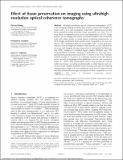| dc.contributor.author | Hsiung, Pei-Lin | |
| dc.contributor.author | Nambiar, Prashant R. | |
| dc.contributor.author | Fujimoto, James G. | |
| dc.date.accessioned | 2014-06-05T13:30:16Z | |
| dc.date.available | 2014-06-05T13:30:16Z | |
| dc.date.issued | 2006-01 | |
| dc.date.submitted | 2005-08 | |
| dc.identifier.issn | 10833668 | |
| dc.identifier.issn | 1560-2281 | |
| dc.identifier.uri | http://hdl.handle.net/1721.1/87640 | |
| dc.description.abstract | Ultrahigh resolution optical coherence tomography (OCT) is an emerging imaging modality that enables noninvasive imaging of tissue with 1- to 3-μm resolutions. Initial OCT studies have typically been performed using harvested tissue specimens (ex vivo). No reports have investigated postexcision tissue degradation on OCT image quality. We investigate the effects of formalin fixation and commonly used cell culture media on tissue optical scattering characteristics in OCT images at different times postexcision compared to in vivo conditions. OCT imaging at 800-nm wavelength with 1.5-μm axial resolution is used to image the hamster cheek pouch in vivo, followed by excision and imaging during preservation in phosphate-buffered saline (PBS), Dulbecco's Modified Eagle's Media (DMEM), and 10% neutral-buffered formalin. Imaging is performed in vivo and at sequential time points postexcision from 15 min to 10 to 18 h. Formalin fixation results in increases in scattering intensity from the muscle layers, as well as shrinkage of the epithelium, muscle, and connective tissue of ∼50%. PBS preservation shows loss of optical contrast within two hours, occurring predominantly in deep muscle and connective tissue. DMEM maintains tissue structure and optical scattering characteristics close to in vivo conditions up to 4 to 6 h after excision and best preserved tissue optical properties when compared to in vivo imaging. | en_US |
| dc.description.sponsorship | National Institutes of Health (U.S.) (RO1-CA75289-06) | en_US |
| dc.description.sponsorship | National Science Foundation (U.S.) (ECS-01-19452) | en_US |
| dc.description.sponsorship | National Science Foundation (U.S.) (BES-0119494) | en_US |
| dc.description.sponsorship | United States. Air Force Office of Scientific Research (Medical Free Electron Laser Program F49620-01-1-0186) | en_US |
| dc.description.sponsorship | The Poduska Family Foundation (Fund for Innovative Research in Cancer) | en_US |
| dc.language.iso | en_US | |
| dc.publisher | SPIE | en_US |
| dc.relation.isversionof | http://dx.doi.org/10.1117/1.2147155 | en_US |
| dc.rights | Article is made available in accordance with the publisher's policy and may be subject to US copyright law. Please refer to the publisher's site for terms of use. | en_US |
| dc.source | SPIE | en_US |
| dc.title | Effect of tissue preservation on imaging using ultrahigh resolution optical coherence tomography | en_US |
| dc.type | Article | en_US |
| dc.identifier.citation | Hsiung, Pei-Lin, Prashant R. Nambiar, and James G. Fujimoto. “Effect of Tissue Preservation on Imaging Using Ultrahigh Resolution Optical Coherence Tomography.” Journal of Biomedical Optics 10, no. 6 (2005): 064033. © 2005 SPIE | en_US |
| dc.contributor.department | Massachusetts Institute of Technology. Department of Electrical Engineering and Computer Science | en_US |
| dc.contributor.department | Massachusetts Institute of Technology. Division of Comparative Medicine | en_US |
| dc.contributor.department | Massachusetts Institute of Technology. Research Laboratory of Electronics | en_US |
| dc.contributor.mitauthor | Hsiung, Pei-Lin | en_US |
| dc.contributor.mitauthor | Nambiar, Prashant R. | en_US |
| dc.contributor.mitauthor | Fujimoto, James G. | en_US |
| dc.relation.journal | Journal of Biomedical Optics | en_US |
| dc.eprint.version | Final published version | en_US |
| dc.type.uri | http://purl.org/eprint/type/JournalArticle | en_US |
| eprint.status | http://purl.org/eprint/status/PeerReviewed | en_US |
| dspace.orderedauthors | Hsiung, Pei-Lin; Nambiar, Prashant R.; Fujimoto, James G. | en_US |
| dc.identifier.orcid | https://orcid.org/0000-0002-0828-4357 | |
| mit.license | PUBLISHER_POLICY | en_US |
| mit.metadata.status | Complete | |
